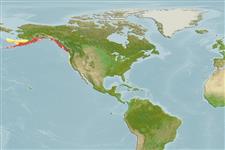Environment: milieu / climate zone / depth range / distribution range
Ecologie
marien demersaal; diepte 6 - 128 m (Ref. 12204). Temperate; 60°N - 38°N, 175°W - 120°W
Northeast Pacific: southeast Bering Sea to northern California, USA.
Grootte / Gewicht / Leeftijd
Maturity: Lm ? range ? - ? cm
Max length : 117 cm TL mannelijk / geslacht onbekend; (Ref. 12204)
Korte beschrijving
Determinatiesleutels | Morfologie | Morfometrie
Dorsale stekels (totaal) : 72 - 77; Dorsale zachte stralen (totaal) : 0; Anale stekels: 2; Anale zachte stralen: 43 - 49. Pale brown in color, with touches of yellow or violet (Ref. 12204).
Found on soft bottoms (Ref. 12204). Probably spends part of its life buried (Ref. 12204).
Levenscyclus en paargedrag
Maturiteit | Voortplanting | Paaien | Eieren | Fecunditeit | Larven
Coad, B.W., 1995. Encyclopedia of Canadian fishes. Canadian Museum of Nature and Canadian Sportfishing Productions Inc. Singapore. (Ref. 12204)
Status op de Rode Lijst van het IUCN (Ref. 130435: Version 2024-1)
Gevaar voor de mens
Harmless
Gebruik door de mens
Tools
Speciale rapporten
Download XML
Internetbronnen
Estimates based on models
Preferred temperature (Ref.
123201): 4.1 - 10.1, mean 6.8 °C (based on 180 cells).
Fylogenetische diversiteitsindex (Ref.
82804): PD
50 = 0.6250 [Uniqueness, from 0.5 = low to 2.0 = high].
Bayesian length-weight: a=0.00389 (0.00180 - 0.00842), b=3.12 (2.94 - 3.30), in cm total length, based on all LWR estimates for this body shape (Ref.
93245).
Trofisch niveau (Ref.
69278): 3.1 ±0.1 se; based on size and trophs of closest relatives
Fishing Vulnerability (Ref.
59153): High to very high vulnerability (70 of 100).
